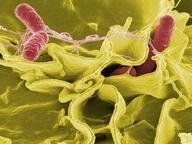Quiz Answer Key and Fun Facts
1. What is the scientific name for the disease caused by 'flesh-eating bacteria'?
2. Which of the following is true about the name 'flesh-eating bacteria'?
3. Despite its frightening name, the 'flesh-eating disease' is actually harmless.
4. Who was the first person to give this condition its (scientific) name, and in what year did this happen?
5. Of the following options, in what group is the 'flesh-eating disease' most likely to develop?
6. How is the 'flesh-eating disease' most commonly treated?
7. Which of the following are symptoms of the 'flesh-eating disease'?
8. Of the following 4 people, which real person lost a leg to the 'flesh-eating disease'?
9. At what location does the 'flesh-eating disease' usually begin to develop?
10. What is/are the standard precaution(s) everybody can take to try preventing getting infected by 'flesh-eating bacteria'?
Source: Author
froggyx
This quiz was reviewed by FunTrivia editor
WesleyCrusher before going online.
Any errors found in FunTrivia content are routinely corrected through our feedback system.


